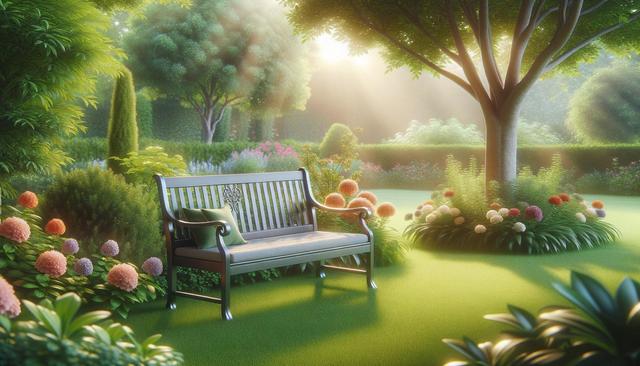The Importance of Weather Resistance in Outdoor Furniture
When selecting furniture for your garden or patio, durability is a key factor to consider. Outdoor furniture, especially benches, are exposed to a range of weather conditions including rain, sunlight, humidity, and even snow, depending on the region. A weather resistant outdoor garden bench ensures longevity and reduces the need for frequent maintenance or replacement. Weather resistance not only protects the bench from physical damage but also helps maintain its appearance over time. Furniture made with weather-resistant materials can better withstand UV rays, moisture, and temperature fluctuations, which are common causes of warping, fading, and rusting.
Opting for materials that are inherently weather-resistant can make a significant difference. Some popular choices include:
- Teak wood, known for its natural oils that repel water
- Powder-coated aluminum, which resists rust and corrosion
- High-density polyethylene (HDPE), a type of plastic that doesn’t crack or fade
- Stainless steel, particularly in coastal areas where salt air is a concern
Choosing the right material is the first step in ensuring your garden bench stays in excellent condition for years to come.
Design Features That Enhance Durability
Aside from material selection, the design of a weather resistant outdoor garden bench plays a crucial role in its durability. Features such as slatted seating and backrests allow for water drainage, reducing the chance of pooling and mold development. Benches with contoured seats and ergonomic backs also provide added comfort while promoting airflow, helping the bench dry faster after rain.
Some design elements to look for include:
- Protective finishes like sealants or UV-resistant coatings
- Reinforced joints and hardware to withstand strong winds
- Non-porous surfaces to prevent water absorption
- Rubber or plastic feet to elevate the bench slightly off the ground
Benches that incorporate these thoughtful design features tend to perform better in unpredictable weather, maintaining both function and visual appeal across seasons.
Maintenance Tips for Long-Lasting Use
Even the most durable weather resistant outdoor garden bench benefits from regular maintenance. While these benches are designed to resist the elements, taking proactive steps can extend their lifespan and keep them looking their best. Cleaning the bench periodically with mild soap and water helps remove dirt and debris that might lead to surface damage or mildew.
For wooden benches, resealing or re-oiling annually can help preserve the wood’s natural resistance to moisture. Metal benches might require occasional touch-ups to their protective coating to prevent oxidation. Plastic materials are typically low-maintenance but can benefit from UV protectant sprays to reduce fading.
Here are a few general care tips:
- Store or cover the bench during extreme weather conditions
- Inspect hardware and joints regularly for wear or loosening
- Keep the bench on a solid, level surface to avoid unnecessary strain
- Use outdoor cushions that are weatherproof and easy to clean
With simple maintenance habits, your garden bench can remain a reliable and attractive fixture in your outdoor space for many years.
Blending Style with Practicality
Weather resistant outdoor garden benches don’t have to sacrifice style for function. A wide range of designs are available to match various landscape themes and personal tastes. Whether you prefer a rustic wooden look, a sleek modern design, or a classic wrought iron frame, there’s a bench that fits both your aesthetic and practical needs.
Consider the overall design of your outdoor space when choosing a bench. For example:
- Rustic gardens may benefit from natural wood or stone finishes
- Modern patios often pair well with metal or composite materials
- Classical themes may call for ornate details and curved lines
- Minimalist spaces work well with clean edges and neutral tones
In addition to appearance, think about the bench’s intended function. Will it be a focal point in your garden? A resting spot by the walkway? Or additional seating for gatherings? These factors will guide your choice in size, material, and design features.
Where to Place Your Garden Bench
Placement is another key consideration when adding a weather resistant outdoor garden bench to your landscape. The right location can enhance both the functionality and enjoyment of your bench. Ideally, the spot should offer a balance of shade and sun while integrating seamlessly into your overall garden layout.
Some popular placement ideas include:
- Under a tree or pergola for a shaded reading nook
- Near a flower bed or water feature for a scenic view
- Along a path or walkway for convenient rest stops
- On a patio or deck as part of a larger seating arrangement
Also, consider the surface on which the bench will sit. Placing it on gravel, concrete, or pavers can help prevent moisture absorption and instability. Avoid placing benches directly on soil or grass, which may lead to faster wear and potential sinking into the ground.
Strategic placement enhances the functionality of your bench while also contributing to the aesthetic harmony of your outdoor space.
Conclusion: A Smart Investment for Your Outdoor Living
Investing in a weather resistant outdoor garden bench is a practical decision for those who value both comfort and longevity in their outdoor furnishings. By choosing durable materials, thoughtful designs, and taking simple maintenance steps, homeowners can enjoy both the form and function of their bench throughout the year. Whether you’re seeking a quiet place to relax or additional seating for guests, a well-chosen bench adds lasting value and charm to your garden or patio. With a variety of styles and features available, it’s easy to find a bench that enhances your outdoor living experience while standing strong against the elements.







